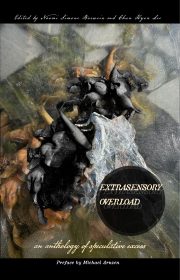Why Writing Second Person POV Appeals To Marginalized Writers
by Valerie Valdes
Note: This article previously appeared in The Bulletin #216 in October 2021.
You open the SFWA Bulletin to start reading an article about second person point of view (POV), and immediately you’re put off. You didn’t expect the article itself to use this POV, since most articles don’t. What a cheap gimmick, you think. You wonder whether you should stop reading at this point, because you’ve been told how you feel and what you expected in the span of a few sentences, and you’re growing increasingly uncomfortable—angry, even—with these assumptions made by the writer. She doesn’t know you! Why is she trying to put words in your mouth and thoughts in your head? Why is she presuming to control your actions?
But seriously, how did that make you feel?
Of all the points of view available to writers when choosing how to tell a story, second person seems to be the most maligned. Common objections include that it’s confusing, unsettling, and weird, that it breaks suspension of disbelief and forces the reader out of the story rather than drawing them in. Dig deeper and you may hear that it’s more than discomfiting, it’s downright presumptuous, even aggressive. The writer is forcing you to think or feel a certain way, crafting a costume and then jamming you, an innocent voyeur, inside, tying you up with strings and putting you on a stage to perform the story like a puppet rather than allowing you the comfort and distance of being in the audience.
In recent conversations about this topic, an interesting trend emerged: many marginalized writers, especially BIPOC ones, expressed that they had written second person POV stories and found the form quite natural, even desirable for their specific purposes. Why might that be, and what are those purposes precisely? As with most other aspects of society, much of this is rooted in how marginalized folks are already expected to adjust our needs and wants to what’s available, while those in the perceived “mainstream” expect what’s available to be created with their needs and desires already in mind.
Marginalized people routinely interact with, are employed and governed by people unlike us, in our daily lives as well as in much of the various media we consume. We are expected to thoroughly comprehend, empathize with, and even inhabit the perspectives of these people because our success or survival essentially depends on it to varying degrees. Media market reports and studies show that narratives written by, for, and about majority groups comprise most of what is traditionally published every year. Even when a book is about a member of a marginalized group, it may not be written by someone from that group; for example, according to the Cooperative Children’s Book Center (CCBC) 2019 survey results on diversity in children’s and YA literature, only 46.4 percent of books featuring Black/African characters were written or illustrated by Black/African authors.
For many marginalized folks, as readers we often experience fiction as a window rather than a mirror. We are more likely to be accustomed to dealing with discomfort or a lack of familiarity related to the characters we’re reading about, their lives and thoughts and choices and so on. The mirrors that do exist may be flawed, warped like carnival glass, reflecting not merely an alternate form of a particular identity, but one that is rendered so imperfectly, regardless of intent, that its subject is barely recognizable. Many of us have become reconciled to the fact that fiction with experiential reality is a form of labor that becomes natural with time and repetition, by necessity. Without that skill, it’s challenging to, for example, navigate situations like basic educational systems and standardized testing due to their use of presumed “universal” touchstones that are only really “universal” to a select group.
We often have to code-switch to engage with others, so it can feel more natural for us to accept and inhabit different selves without fear of losing the core of who we are. One more shift into another facade doesn’t feel like an intrinsic attack on our personhood; it’s simply a different manifestation of how we’re already required to engage with society at-large. Alternately, we’ve already come to many stories from a place of destabilized or complex identity due to our own individual experiences. Many marginalized people may be members of multiple cultures with differing traditions and norms and expectations that have to be reconciled—or perhaps can’t be. We’re familiar with feeling alienated in both social and literary settings. Grappling with those emotions on a daily basis makes it easier to do so on demand, though this doesn’t make the process intrinsically pleasant or desirable.
As a result, a form like second person isn’t especially more disorienting than first or third person, because we’re already prepared to suspend disbelief to a greater extent than readers for whom the usual experience is more intrinsically accessible. We already expect to be presented with characters unlike ourselves, requiring that we engage with them and their story by first attempting to calibrate our perceptual filters to let us see it all from the perspective of the target audience. In a sense, to read most stories, we must already pretend to be another person on some level, or we’re likely to find it challenging to connect meaningfully to the text—the elusive “relatability” metric in action.
While first and third person are functionally tourist approaches, in which the distance between reader and character or narrator is maintained to a greater extent, second person dissolves the barrier or renders it as transparent as possible. When confronted with stories by writers from marginalized groups, readers from a majority group are often called to expend greater effort to engage and relate and filter, assuming the writer didn’t deliberately set out to make the work fit within the expected framework of cultural conventions. For majority group readers, the experience becomes more about questioning of the nature of who “you” are within the story, instead of it being more explicitly and accessibly shown or told. Because of the othering that often occurs in such stories, second person can serve as a radical tool to impose alternate perspectives in a more immediate and intentionally discomfiting way. It is both intimate and coercive, which is perhaps why those who are used to reading stories that implicitly cater to and reflect their own lives can find second person so discomfiting.
An excellent example of this barrier dissolution, throwing open the window and pulling you straight into the mirror, is “Welcome to Your Authentic Indian Experience” by Rebecca Roanhorse. This story uses second person to locate you within the life of someone who is not only tasked with guiding non-Native people through an inaccurate virtual reality facsimile of his own culture while pretending to be a caricature of himself, but whose life and personhood are ultimately stolen by one of the guests to whom he was attempting to cater. The layering of fabrications and realities and the ultimate reproduction of an extremely true Indian experience are perfectly presented through the use of this perspective. Reframing this story in first or third person would intrinsically undermine not only its intended effect, but also its thematic content. The process it depicts is a dehumanizing violation of both a culture and an individual. It should be disorienting and unsettling. It should make you uncomfortable, at the very least. It should inspire a sense of the frustration and helplessness the character himself suffers from. It seeks to strip away the safety of distance that other POVs allow, and without that distance, the jagged edges of the mirror can wound deeply. You have no structural shield to protect yourself from that pain. Worse, upon finishing the story, you must grapple with the ways you are complicit in causing the pain in the first place, through your own action or inaction.
The expectation of being able to take action and have agency when engaging with fiction may perhaps be part of the issue for non-marginalized readers encountering second person perspectives. A frequent caveat to the dislike of such narratives is “choose your own adventure” stories or similar interactive fiction, in which you are given explicit control over character choices and, through those, the direction of the plot. More broadly, Western stories are often concerned with agency—portraying characters who are in a position where they are the person best equipped to handle a particular problem by virtue of their own skills, abilities, other inherent qualities and, most vitally, the power those combined aspects give that person over guiding their own destiny.
Second person POV stories, by contrast, force you to inhabit a position without agency over the character’s choices. You are the character, but you are also the observer, active and passive simultaneously, compelled to act and react without being able to exert control over the situation. Whether the character has agency varies, but it’s often the case, especially with stories by marginalized people, that the ability to exert influence over the events in the narrative may be impaired by external forces. The story itself may be about dealing with the lack of agency, or gaining some semblance of agency, however small. So not only do you have to effectively lack agency in the usual manner of non-interactive fiction, you must be engaged actively in the role of someone who themselves lacks agency. For those accustomed to having agency in their lives and in their fiction, it’s doubly unpleasant. You cannot “win” a story written in second person the way you can “win” a game. You may, in fact, be forced to “lose” and deal with the consequent emotions.
Second person perspective can also be disorienting for readers looking to capture that elusive “relatability” because it often functions as a dialogue with the self. Because of the challenges that marginalized people often endure—the microaggressions and traumas, the breadth and depth of pleasure and pain linked intrinsically to our identities—fiction can function as a means of personal exploration in which we must become narrators or explicators of our own lives in order to process them. For the reader, it’s a way of removing barriers; for the writer, it can instead be a way of erecting them. That can yield a story so fundamentally rooted in a specific experience that an outsider reflexively rejects the invitation to become that person, not because the rendering of the character is flawed or unbelievable, but because the reader struggles to lower their own internal barriers to entry for whatever reason.
None of this examination is meant to be a condemnation if you don’t enjoy reading stories written from a second person POV, nor is it a veiled accusation of lack of empathy or racism, or a suggestion that only marginalized people can write this perspective effectively. It’s a tool, and like any tool, there are craft considerations that make its use more or less appropriate and effective. It is nonetheless interesting to note the reasons for dismissing the validity of the tool or questioning its efficacy—the confusion, the discomfort, the presumption, the sense of being coerced and othered. Those may in fact be the most compelling arguments for why more people should read such stories, especially the ones written by marginalized authors.
Sometimes, you need to become the person in the mirror, even if they look like someone completely different from you, someone you’ve never seen before in your life.
 Valerie Valdes’s work has been featured in Uncanny Magazine, Time Travel Short Stories, and Nightmare Magazine. Her debut novel Chilling Effect was named one of Library Journal’s best SF/fantasy novels of 2019, and was shortlisted for the 2021 Arthur C. Clarke Award. The sequel, Prime Deceptions, was published in September 2020. Valerie currently works as a freelance writer and copy editor. She lives in Georgia with her husband, children, and cats.
Valerie Valdes’s work has been featured in Uncanny Magazine, Time Travel Short Stories, and Nightmare Magazine. Her debut novel Chilling Effect was named one of Library Journal’s best SF/fantasy novels of 2019, and was shortlisted for the 2021 Arthur C. Clarke Award. The sequel, Prime Deceptions, was published in September 2020. Valerie currently works as a freelance writer and copy editor. She lives in Georgia with her husband, children, and cats.


